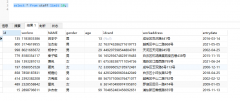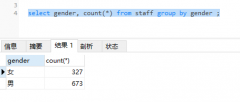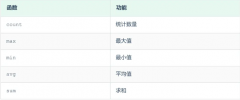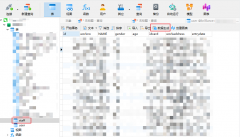Recursively retrieve LAG() value of previous record(递归检索上一条记录的 LAG() 值)
问题描述
我进行了以下涉及 LAG() 的计算:
I've made the following calculation involving LAG():
(lag(fValue,1,fValue) OVER (PARTITION BY Cluster ORDER BY iSequence) + fValue)/2 as fValueAjusted
它取前一个(基于 iSequence)记录的 fValue,与当前记录相加,然后除以 2.
It takes the previous (based on iSequence) record's fValue, sums with current one, and divides it by 2.
但是,我必须使用上一条记录的 fValueAjusted,而不是使用 fValue.
But, instead of using fValue, I must do that using previous record's fValueAjusted.
这意味着第一条记录的 fValueAjusted 将是它自己的 fValue.第二条记录的 fValueAjusted 将基于第一条记录的 fValue.并且,从第三条记录开始,它的计算将基于前一条记录的 fValueAjusted.
It means that first record's fValueAjusted will be its own fValue. Second record's fValueAjusted will be based on first record's fValue. And, starting from third record, it's calculation will be based on previous record's fValueAjusted.
我需要在前一条记录的 fValueAjusted 上递归计算 fValueAjusted.我不知道该怎么做.
I need fValueAjusted to be calculated recursively over the previous record's fValueAjusted. I can't figure out how to do that.
更新 1:这是一个源数据示例.真实表有数百条记录和80个簇.
Update 1: This is an example of source data. Real table has hundreds of records and 80 clusters.
CREATE TABLE dbo.example (
iUnity int NOT NULL,
Cluster char(2) NOT NULL,
fValue float NOT NULL
)
15 A1 150
17 A1 170
21 B2 210
23 B2 230
71 C3 710
这是计算序列的CTE:
This is the CTE that calculates the sequence:
WITH cteSequencing AS (
SELECT
iUnity,Cluster
,fValue as fValueOriginal
,row_number() OVER (PARTITION BY Cluster ORDER BY fValueOriginal) as iSequence
FROM dbo.example
)
如果 fValueAjusted 将基于 fValueOriginal 计算,则查询将如下所示:
If fValueAjusted would be calculated based on fValueOriginal, the query would look like:
SELECT
iUnity,Cluster,fValueOriginal
,(
lag(fValue,1,fValue) OVER (PARTITION BY Cluster ORDER BY iSequence)
+ fValueOriginal
) / 2 as fValueAjusted
FROM cteSequencing
但是一个记录的 fValueAjusted 必须根据前一个记录的 fValueAjusted 计算.它会是这样的:
But fValueAjusted of one record must be calculated based on fValueAjusted of previous record. It would be something like:
SELECT
iUnity,Cluster,fValueOriginal
,(
lag(fValueAjusted,1,fValueOriginal) OVER (PARTITION BY Cluster ORDER BY iSequence)
+ fValueOriginal
) / 2 as fValueAjusted
FROM cteSequencing
当然 fValueAjusted 在执行时不可用.LAG() 必须递归进行,计算记录的列,然后提供该列供下一条记录使用.
Of course fValueAjusted isn't available when it executes. LAG() must go recursively, calculating the column for a record then providing this column for next record to use.
推荐答案
更新:原始答案不正确
正确的是:
代码使用递归 CTE
CREATE TABLE #example (
iUnity int NOT NULL,
Cluster char(2) NOT NULL,
fValue float NOT NULL
)
INSERT INTO #example
VALUES
( 15, 'A1', 150 ),
( 16, 'A1', 170 ),
( 17, 'A1', 190 ),
( 18, 'A1', 210 ),
( 21, 'B2', 210 ),
( 23, 'B2', 230 ),
( 71, 'C3', 710 )
WITH cteSequencing AS (
-- Get Values Order
SELECT iUnity, Cluster, fValue, fValue AS fValueAjusted,
ROW_NUMBER() OVER (PARTITION BY Cluster ORDER BY fValue) AS iSequence
FROM #example
),
Recursion AS(
-- Anchor - the first value in clusters
SELECT iUnity, Cluster, fValue, fValueAjusted, iSequence
FROM cteSequencing
WHERE iSequence = 1
UNION ALL
-- Calculate next value based on the previous
SELECT b.iUnity As iUnity, b.Cluster, b.fValue,
( a.fValueAjusted + b.fValue ) / 2 AS fValueAjusted,
b.iSequence
FROM Recursion AS a
INNER JOIN cteSequencing AS b ON a.iSequence + 1 = b.iSequence AND a.Cluster = b.Cluster
)
SELECT * FROM Recursion ORDER BY Cluster, fValue
-- Manually check results
SELECT ( 150 + 170 ) / 2
SELECT ( 190 + 160 ) / 2
SELECT ( 190 + 170 ) / 2
输出:
iUnity Cluster fValue fValueAjusted iSequence
----------- ------- ---------------------- ---------------------- --------------------
15 A1 150 150 1
16 A1 170 160 2
17 A1 190 175 3
18 A1 210 192.5 4
21 B2 210 210 1
23 B2 230 220 2
71 C3 710 710 1
更新
如果遇到
最大递归100在语句前已用完完成
The maximum recursion 100 has been exhausted before statement completion
错误,然后使用 OPTION (MAXRECURSION xxx) 设置更大的递归限制,最高可达 32,767.
error, then use OPTION (MAXRECURSION xxx) to set a larger recursion limit up-to 32,767.
这篇关于递归检索上一条记录的 LAG() 值的文章就介绍到这了,希望我们推荐的答案对大家有所帮助,也希望大家多多支持编程学习网!
本文标题为:递归检索上一条记录的 LAG() 值


基础教程推荐
- while 在触发器内循环以遍历 sql 中表的所有列 2022-01-01
- 带更新的 sqlite CTE 2022-01-01
- CHECKSUM 和 CHECKSUM_AGG:算法是什么? 2021-01-01
- 如何在 CakePHP 3 中实现 INSERT ON DUPLICATE KEY UPDATE aka upsert? 2021-01-01
- MySQL 5.7参照时间戳生成日期列 2022-01-01
- 使用 VBS 和注册表来确定安装了哪个版本和 32 位 2021-01-01
- 从字符串 TSQL 中获取数字 2021-01-01
- MySQL根据从其他列分组的值,对两列之间的值进行求和 2022-01-01
- 带有WHERE子句的LAG()函数 2022-01-01
- ORA-01830:日期格式图片在转换整个输入字符串之前结束/选择日期查询的总和 2021-01-01

















